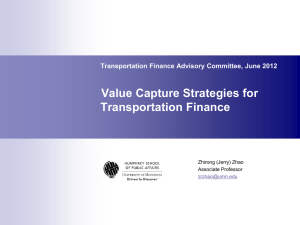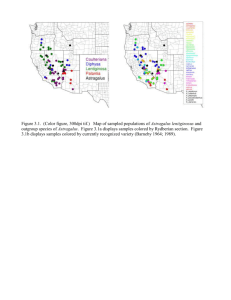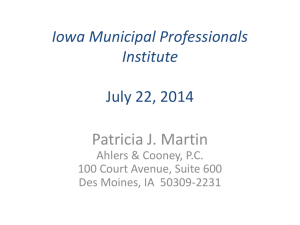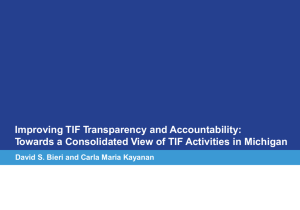TIF and Beyond - Iowa League of Cities
advertisement
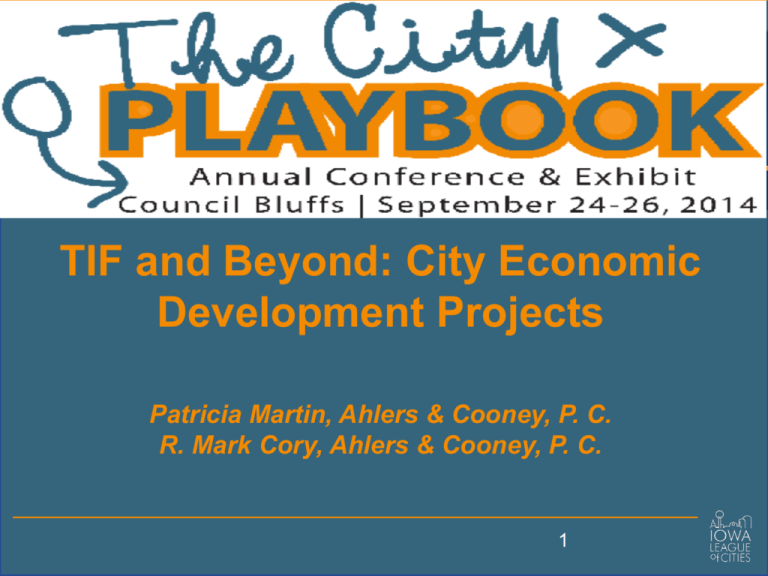
TIF and Beyond: City Economic Development Projects Patricia Martin, Ahlers & Cooney, P. C. R. Mark Cory, Ahlers & Cooney, P. C. 1 CAVEAT This Guide is intended for general informational purposes only. Answers to legal questions about Iowa urban renewal law can vary greatly depending upon the specific facts in a given situation. Please consult an attorney. 2 Housing Incentive Options Urban Revitalization Pros Cons County Assessor takes over administration No tax increment is created (meaning all financial benefits go to the owner) Easy to amend term/schedules Attractive schedules if you can meet requirements Burdensome to start one Urban Renewal Pros Tax increment is created Cons Administration; Limited options for non3 LMI housing Attractive schedules if: • Area is designated as blight and you want to include single family residential • If housing is for LMI individuals/families • If building is multi-residential (3 or more housing units and up to 75% of sq. ft. is residential) 4 • How attractive? Up to 100% for up to 10 years –Can be a smaller percentage and smaller number of years. 5 CITY ONLY INCENTIVE AGREEMENTS When are these useful? • Only one parcel is involved • Mid-level projects • Or retail How does a city get this authority? »Iowa Code section 15A.1 »Must be tied to the creation or retention of jobs 6 CITY ONLY INCENTIVE AGREEMENTS Pros NO UR Plan, no amendments No UR reporting Cons No tax increment is created No county or school effect because city is Rebates are smaller because city has only accessing its own taxes access to only its taxes to rebate Less complex agreement Consider whether 384.24A(4) is applicable. (loan agreement procedure) 7 7 1. Developer (Business) completes a project with an assessed value of at least X dollars. What is X? X depends on your city. It may be $500,000 for a small city and $1.0 M for a larger city or some different minimum. 2. Developer (Business) either agrees to retain X jobs and/or create Y new jobs. 3. Developer (Business) enters into a short development agreement and Developer annually certifies that: • Developer (Business) is still operating the business • Developer (Business) has paid all property taxes for this parcel (and all other commercial parcels) and • Developer (Business) has retained X employees and/or hired Y employees. 4. If so, Developer (Business) receives a % of city-only taxes or all the city 8 taxes except the City’s debt service levy for X years. LEAGUE’S “SNAPSHOT OF TAX INCREMENT FINANCE” SAYS: 1,530 TIF Districts out of 2,528 total TIF Districts had a base year after 1995 (61%) and 75% of those had a statutory end date WHAT DOES THIS MEAN? 9 END OF LIFE DISCUSSION STARTING FOR ECONOMIC DEVELOPMENT PLANS/AMENDMENTS ADOPTED AFTER 1/1/95, THERE IS A 20 YEAR LIMITATION ON THE COLLECTION OF TIF “If an urban renewal plan for an urban renewal area is based upon a finding that the area is an economic development area and that no part contains slum or blighted conditions, then the division of revenue provided in section 403.19 and stated in the plan shall be limited to twenty years from the calendar year following the calendar year in which the municipality first certifies to the county auditor the amount of any loans, advances, indebtedness, or bonds which qualify for payment from the division of revenue provided in section 403.19.” Iowa Code Section 403.17(10).” 10 EXAMPLE Question: What if the City adopted an ED plan on 1/2/95, and adopted a TIF ordinance on that entire Plan Area on 1/2/95 and the City then certified debt by 12/1/95, when is the sunset? Answer: The last fiscal year to collect tax increment on the area within that TIF Ordinance (the entire URA) is FY 15-16. Given that we are currently in FY 14-15, that is our next fiscal year. In fact, under that scenario, if your last fiscal year to collect TIF is FY 15-16, you would have to certify by 12/1/14 to get the FY 15-16 increment. 11 First of all: The statutory limit is on the collection of tax increment within a TIF ordinance of an economic development urban renewal area. • • • It is not a limit on the duration of a Plan. It is not a limit of how long an area can be covered by a Plan. It is not applicable to mixed Economic Development/ Blight areas 12 • What to do? 13 14 OPTION: Take out the undeveloped land from the urban renewal area and create a new UR area using some or all of the undeveloped land and perhaps additional undeveloped land. 15 What have you lost? The land you cut out gets a new stepped-up base (January 1 of the year before debt is first certified) but you may not lose much because undeveloped land will likely still have a relatively low base value. 16 When should you do this? a) Right now OR b) Wait until a prospect that wants to build shows up so you don't waste your money on creating an URA that is not yet needed or contains the wrong parcels. 17 What if you guessed right? If Original Area is all developed, you don’t need to do anything. Remember, even if you do nothing, while the ability to collect Increment expires on the Original Area.... you can still use Increment from the Amendment No. 1 Area on UR projects in the Original Area. 18 How to Put Projects on the Board 19 Sometimes, rebate agreements do not achieve the desired results. 1. City needs to build infrastructure 2. Project requires cash “up front” (needs, not developer wants) 3. Other unique circumstances 20 Which play should you run? 21 Joint efforts of City, UR counsel and bond counsel 22 384.24(3)(q) Essential Purpose: “aiding in the planning, undertaking, and carrying out of urban renewal projects under the authority of chapter 403… .” 23 384.24(3)(q) 1. G.O. Debt Service Levy Available 2. Requires Valid UR Purpose under Statute and UR Plan 3. Subject to 10/20 Notice and Reverse Referendum 4. May or May not Certify for TIF Reimbursement 24 403.12 1. Requires Valid UR Purpose under Statute and UR Plan 2. GO Debt Service Levy Available 3. 10/20 Reverse Referendum 4. Public Sale 5. May or May not Certify 25 384.24 (not “q” purpose) Many times, an urban renewal project undertaking constitutes an essential purpose on its own, such as a street, water, sanitary sewer, storm sewer, sidewalk, etc. 26 384.28 allows the council to “elect” which procedures to follow “when a project or activity may be reasonably construed to be included in more than one classification” under the definitions of essential and general corporate purposes. 27 Election Considerations UR Purpose Standard ECP Purpose • Clear intent to treat as UR project • Easy proof of council approval • Less chance of dispute over reimbursement eligibility • 4/20 notice – no reverse referendum 28 1. 2. 3. 4. 403.9 Urban Renewal Revenue Requires valid UR purpose under statute and plan 4/20 hearing No reverse referendum, but no debt service levy Payable only from TIF or other project income 29 Option Plays 1. Start 403.12/384.24(3)(q) and 403.9 at same time 2. Conduct two or more ECP and or GCP purpose hearings in addition to 403.12/384.24(3)(q) 3. 403.9 and multiple G.O. Hearings 30 31 • Questions? • R. Mark Cory, rcory@ahlerslaw.com • Pat Martin, pmartin@ahlerslaw.com 1052933 32
